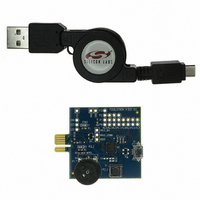TOOLSTICK321DC Silicon Laboratories Inc, TOOLSTICK321DC Datasheet - Page 12

TOOLSTICK321DC
Manufacturer Part Number
TOOLSTICK321DC
Description
DAUGHTER CARD TOOLSTCK C8051F321
Manufacturer
Silicon Laboratories Inc
Series
ToolStickr
Type
MCUr
Specifications of TOOLSTICK321DC
Contents
Board, Cable
Processor To Be Evaluated
C8051F321
Interface Type
USB
Operating Supply Voltage
2.7 V to 3.6 V
Lead Free Status / RoHS Status
Lead free / RoHS non-compliant
For Use With/related Products
C8051F321
For Use With
336-1345 - TOOLSTICK BASE ADAPTER336-1182 - ADAPTER USB DEBUG FOR C8051FXXX
Lead Free Status / Rohs Status
Lead free / RoHS Compliant
Other names
336-1480
Available stocks
Company
Part Number
Manufacturer
Quantity
Price
Company:
Part Number:
TOOLSTICK321DC
Manufacturer:
Silicon Laboratories Inc
Quantity:
135
To olSt ick-F 32 1DC
6.8. Using ToolStick Terminal
This section describes how to use ToolStick Terminal to communicate with UART from the PC to the daughter card
through the ToolStick Base Adapter.
1. If the Silicon Laboratories IDE is open, close the IDE. The IDE and the ToolStick Terminal cannot communicate
2. Open ToolStick Terminal from the Start → Programs → Silicon Laboratories menu.
3. Go to the ToolStick → Settings menu.
4. Under “Pin Settings”, change GPIO0 / RTS to “GPIO Output - Push Pull” and click “OK.” The rest of the default
5. In the top, left-hand corner of the Terminal application, available devices are shown in the drop-down
6. Turn the potentiometer on the daughter card and see that the blink rate is updated on the daughter card and the
In addition to the standard two UART pins (TX and RX), there are two GPIO/UART handshaking pins on the
ToolStick Base Adapter that are connected to two port pins on the target microcontroller. ToolStick Terminal is used
to configure and read/write these pins. For the F321DC_FeaturesDemo, one of these GPIO pins is connected to
an external interrupt pin on the C8051F321. The following steps describe how to change the level of one of the
GPIO pins and trigger an interrupt on the target microcontroller. The interrupt forces the firmware to switch modes
and send a pulse-width modulated (PWM) signal to the LED instead of blinking the LED using an on-chip Timer.
1. In ToolStick Terminal, under Pin State Configuration, select “Set GPIO0 Logic Low” and click on “Set Selected
2. In the Receive window, see that the printed text has changed to indicate the LED PWM duty cycle.
3. Turn the potentiometer on the daughter card to change the brightness of the LED on the daughter card.
4. Change the GPIO0 pin state back to Logic High and notice that the firmware switches back to blinking the
The firmware on the C8051F321 target microcontroller does not need to be customized to use the UART and
communicate with ToolStick Terminal. The firmware on the microcontroller should write to the UART as it would in
any standard application and all of the translation is handled by the ToolStick Base Adapter.
12
with the daughter card simultaneously.
settings are correct for the C8051F321 Features Demo.
Connection menu. Click “Connect” to connect to the device. In the “Receive Data” window, text indicating the
blink rate of the LED will appear.
new blink rate is printed to the Terminal.
Pin States.” This changes the level of the GPIO0 pin from Logic High to Logic Low and triggers a level-
sensitive interrupt on the microcontroller.
LED.
Rev. 0.1






















